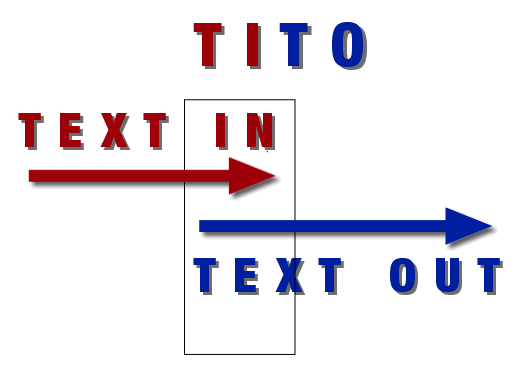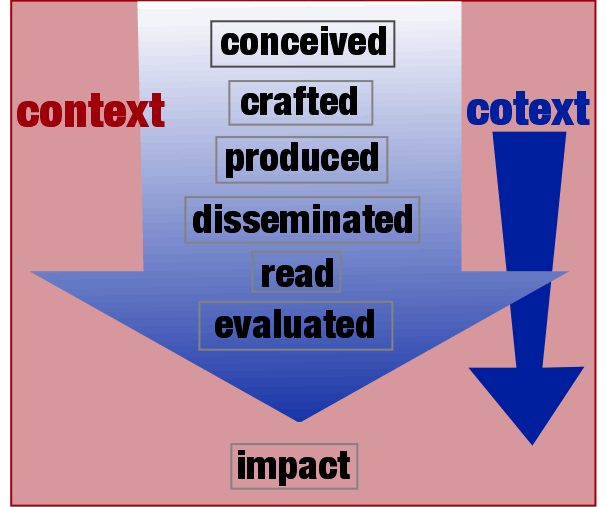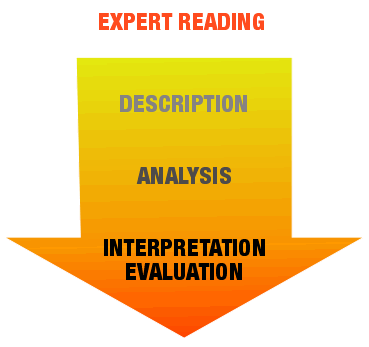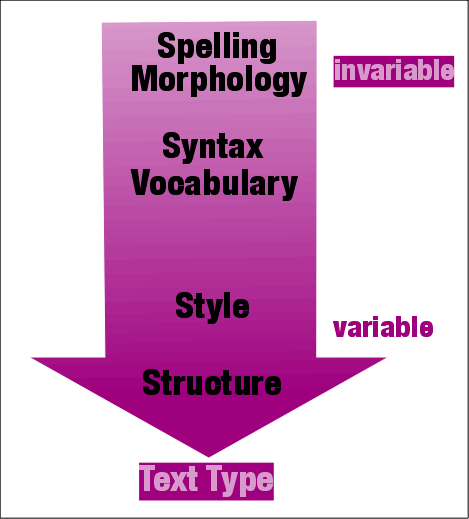GEORGETOWN
UNIVERSITY
FRENCH DEPARTMENT
GATEWAY SEQUENCE
TEXT AND WRITING
The
TITO Principle
- What
is a Text?
- The"TI"
in TITO
- Expert
Reading -
The
"TO" in TITO -
The Writing Process
- Evaluating
a Text
The purpose of this guide is to make you aware of some fundamental notions and principles related to reading, interpreting and producing texts. Specific strategies will be introduced in class, in the context of various reading and writing activities.
TEXT IN - TEXT OUT:
THE TITO PRINCIPLE
Texts, texts, texts everywhere...
We spend our lives surrounded by texts that we must
learn how to read in order to function adequately. Texts come in a great
variety of forms, dozens of which we face every day—even if our
lives are not particularly text-oriented. There are of course "obvious"
texts in the newspaper we read in the morning and in the books that we
typically use in college. There are also myriad texts that we go through
without even realizing that we are, in fact, reading—that is, processing
with skills and strategies that we have learned.
Texts
are absolutely unnatural: human artifacts, constructed with codes that
are not found in nature or built in our genetic make-up. Indeed, human
evolution has been possible only because, somehow, we have managed to
transcend our natural, very limited abilities to communicate by natural
means (that is, orally) through a series of breakthrough inventions, including
several writing systems: cuneiform script, hieroglyphics, ideograms and
various types of alphabets.
 |
It
should come as no surprise, then, that education is greatly
concerned with texts, and that much of what gets done in schools
and universities belongs to what we might call the TITO
(Text In - Text Out)
principle. According to TITO, students are taught increasingly
complex skills and strategies to handle increasingly complex
texts, first as simple readers ("decoders"), then
as expert readers ("interpreters"), and, eventually,
producers. |
WHAT IS A TEXT?
There is a good reason to reflect first upon texts rather
than "language" or "writing," since, in our experience,
we always read before we write (one being an indispensable condition for
the other), and since there is no such thing as simply "reading":
whenever we read, the primary level of coding that we encounter is textual
form. The meaning that we ascribe to words and sentences greatly depends
on text type, text function and genre as we perceive them.
Moreover, a great number of texts are not primarily linguistic
in nature, even when they do involve some language (films, paintings,
buildings, comics, songs) In fact, a text can be broadly defined as anything
designed to be decyphered and understood in a predictable way (i.e.: to
be "read"), and which stands on its own because it has a coherent
and complete structure. A text is not just a random assemblage
of elements: usually, we identify it as a text because its form
is rather specific (and, usually, somewhat familiar), without being absolutely
unique: as a representative of a type to which a number
of individual texts belong.
Perhaps the best way to understand this principle is
to think of the relationship between a house and a stack of timber. Althouth
the house is made from the timbers, there is no mistaking one for the
other, and not simply because their appearances are quite dissimilar—appearances
can be deceitful. The real difference lies first in the fact that a pile
is, by definition, a non-specific assemblage of items: it has no definite
structure and no definite function (or
else it would not merely be a stack). One can move the timbers around,
add or take away a few of them without altering its nature as a stack.
 |
HOUSE STACK |
 |
A
house, on the other hand, has a definite function and a definite
structure that reflects this function. Of course, multiple variations
are possible in the outward appeareance of the house and in its layout,
independently of its structure. The structure itself may vary considerably
depending on the area where the house is erected. The nature of the terrain,
the climate—but also the cultural habits of its dwellers—dictate
choices in design and building materials. A house that is poorly insulated,
poorly laid out, or that collapses is a "bad" house in the sense
that it does not perform well the function for which it was created; however,
it is still a house, not a stack of timber.
In a similar fashion, texts are not images or sounds
or words or sentences thrown together haphazardly: texts have a specific
form that reflects a specific function
and, to some extent, characteristics that reflect cultural traditions
and expectations from the indented audience. Sometimes, efficacy dominates
(such as in instructions manuals for mechanical or electrical equipment);
sometimes, cultural factors are dominant: how can one assess the "efficacy"
of a musical composition or a poem, for instance, other than by the emotional
impact it can have on its listeners or readers? And, certainly, listeners
from different cultural backgrounds will favor different scales, keys,
tempos, sound and rythm patterns, etc. In this sense, musical forms like
the symphony, the sonata, the étude can definitely be
construed as text types: even though music is supposed to be "the
universal language," and though any human being may derive some pleasure
from listening to them, it does take formal knowledge to understand them,
their nuances and the differences between them. In other words, to "read"
them with expertise.
In theory, education, and especially higher education, should expose students to a great variety of texts, and train them to become expert readers, or at least competent readers of complex texts. What does this mean?
To think of a painting, of a building or a city, of a film as texts, and to endeavor to read them as text means first and foremost to recognize that 1) they were created and structured so as to be legible by a certain presumptive audience, in a certain context, and that 2) they are intended to produce certain effects on this audience. Each actual reader in his/her time and place, may of course be affected in a way quite different from what was originally intended: s/he may appreciate a text for other reasons than those intended—or not appreciate it at all. In fact, s/he may even find it illegible, i.e. not understand it.
The "expert" reader, however, should not stop at first impressions, such as liking the text or fidfing it immediately legible; the expert must be able to reconstruct the process through which a text was conceived, crafted, physically produced, disseminated, read and appreciated in a definite context—time, place, cultural setting, circumstances (social, political, institutional, religious) in which author(s) and audience found themselves—and a definitecotext—other similar or comparable texts produced and/or read in the same context.
In reality, the general tendency in education has been to focus on developing students' emotional relationship to texts, on the premise that this was the only way to make science, history, literature, art, film, what have you, interesting and relevant to young people. Unfortunately, this attempt to spark or nurture interest has led to the belief that paying close attention to form is inevitably dry and boring, and that rigorous, analytical or critical reading is always a chore. As a result, expert reading has been construed as antithetical to developing an emotional rapport to a text.
Now, a vast majority of professors believe that genuine appreciation of the text(s) being studied is the ultimate goal of education; good professors know that appreciation and expertise in reading are complementary, and that one should not be sacrificed to the other because ultimately, one depends on the other.
One of the main purposes of the "Gateway sequence" in French studies at GU is to make sure that all of our students are exposed to a variety of texts, and that they are given a palette of strategies to approach these texts as expert readers.
By texts we mean novels, newspaper articles, short stories, scholarly papers, poems, plays, but also films, comics, maps, posters, photographs, paintings, buildings... Beyond their extreme diversity, all these materials can be studied in a systematic manner, which essentially sets apart "common" reading and the expert reading of a scholarly approach. You'll notice that some of these materials belong to what is often refered to as "popular culture": one of the principles behind a scholarly approach is that complexity is in the eye of the beholder: it can be found in virtually any text type, no matter how "simple" or "lowbrow" it may seem. The ordinary reader thinks that the stuff found on a cereal box or a detective story is self-evident and simple, whereas a 1000-page novel by Proust, an philosophical essay by Derrida or a Renaissance sonnet are complex. The expert reader, while remaining aware of the differences between these various texts, knows that all of them are, in their own way, complex; s/he also knows why they are complex, and why some are more interesting, or valuable, or esthetically superior to others.
This isn't to say that for each text, or type of text, there is one, authorized reading method that we are trying to teach you. In fact, you will probably see differences among faculty members in the way they deal with various texts. What truly matters is that you learn the fundamental principles through which you should approach any text.
Another aspect of the Gateway sequence is the acquisition of fundamental principles of composing a text of your own. In most college curricula, this is known as "writing" or "advanced writing"—but in fact there is no such thing as "writing" or "better writing" in the abstract: there is only writing a certain type of text, and "improving" means making your text more efficatious in fulfilling whatever function(s) are ascribed to the text type at hand.
The
great variety of texts to which we are exposed should not induce us
to believe that reading each one requires completely different skills
and strategies (in fact, we need to be cautious of any approach that
works particularly well with one particular text type, but not so well,
or not at all, with others). What matters is that we ask ourselves the
"right" questions, those that allow us to go beyond "naive"
reading and superficial impressions.
The safest way to proceed is to observe three separate stages:
describe, analyze, interpret
(to which we may add a fourth stage: evaluate). Although,
initially, this order needs to be respected, the process will eventually
involve going back and forth between these various operations. Any hypothesis
on meaning (interpretation) requires to be supported by precise factual
observations on the text itself (description), and on the way the text
is supposed to function in actual reading (analysis), that is, in a
precise context (time, place, readership).
a) Description means formulating factual observations on the text, so as to obtain a solid basis for analysis and interpretation. Some questions need to be asked, even if no definitive answers can be found at first:
Are we dealing with a complete text? A portion or excerpt? If it is an excerpt or a portion, who decided on it? The author? (chapters, for instance, are usually attributale to the author) Someone else? (an editor) Accidental circumstances
What are the non-linguistic characteristics of this text? From what elements is it composed (visual, concrete, sounds)?
To what text type does it belong? How can one tell? What type characteristics seem particularly obvious? Does it belong to a known genre?
What seem to be the primary functions of this text? express an opinion or feeling, entertain, move, provoke, shock, inform, present, support or contradict a thesis, amuse?
Is there an explicit narrator, or other device that embodies a point of view within the text? If there is a narrator, is it omniscient? Internal or external to the story being told? From what point of view is this text constructed? Who created it? Who is the intended receptor (audience)?
Are there any characters? Are they human? Anthropomorphic? (an animal, an object, a city, nature can be characters) Is the readers' attention drawn to a specific character, a "hero" (who may have positive or negative traits)?
What are the most obvious linguistic characteristics of this text? Isolated words, full sentences, groups of words or sentences? Is the language used closer to oral or written speech? What register(s) is/are used (formal/standard/colloquial)? Is the vocabulary abstract or concrete? Is there any technical or regional vocabulary? Any slang? How can the style be described? Are there any prominent rhetorical effects?
2) Analysis means showing how the text works—much like one takes apart a watch to study the clockwork. How does it manage to reach its goals, to fulfill its function(s), to have an effect upon the presumptive reader?
What effect(s) is/are predictably indiced by the features we identified in the descriptive stage? Is the reader "brough into" the text? If so, how? Does the author play with (or toy with) the reader? Does the author seek to deliberately mislead the reader, in order to create surprise? To influence the reader or manipulate him/her? How is suspense generated and maintained? Is the reader required to draw his/her own conclusions? To make inferences? Is the author seeking to preserve some ambiguity? Is he being didactic?
If the text is fiction, is there a "reality effect" whereby the reader is induced to forget that s/he is dealing with a work of fiction (for instance through the accumulation of verisimilar technical details: names, places, dates, etc.)
Explaining how a text works may be facilitated by a contrario reasoning, or by considering alternatives: it is easier to understand how a feature of the text produces a certain effect if one envisions what might have occured if another solution had been chosen. This is a good way to test whether a given feature of the text holds particular significance at a deep level of meaning.
Beware of explaining how a text works simply by assuming "intentions" from the author, as if s/he was in full control. It often happens that authors unwillingly and unwittingly reveal themselves through their work, or provoke reactions from readers that they had not anticipated (especially when there is sizable distance—chronological, geographical, cultural—between the author and the eventual audience).
3) Interpretation means eventually proposing hypotheses on possible meanings of the text. When the descriptive and analytical work has be done carefully, it becomes obvious that the meaning of a text, although it can never be established definitively (because various readers will ascribe different meanings), can be framed according to certain objective parameters; in other words, it is not purely a matter of opinion.
Holding and expressing an opinion is a priviledge of every citizen in a free society. Opinion does not have to be justified; it can be totally unsupported and arbitrary, and therefore it carries no particular authority or scientific value. Interpretation, however, has to be justified and supported: even when it is tentative, inconclusive or debatable, it cannot be arbitrary or incoherent.
When reaching the stage of interpretation, it is always useful to get back to one's initial impressions: are they confirmed? Modified? Radically altered? Why? Such verifications often help bring to light devices and strategies in the text that had gone unoticed at first.
4) A final possible stage is evaluation, which may or may not match individual appreciation. An expert reader must be able to recognize and explain the value of a text independently from his/her own opinion or preference. This may be defined in terms of practical, informative, emotional, esthetic value that a text has (or may have) for certain readers, but it can also be expressed as a relative value: why is a text better than another? One easy way out is to adopt a relativistic stance: value is subjective and no text is demonstrably better than another in all circumstances, and for every reader. True as this may be from a strictly philosophical point of view, the fact is that human beings do approach texts with a normative bias rooted in a particular context; a reader's task is, first, to establish why a given text was valued in a certain way (positive or negative) in a given context, and, possibly, decide on the relevance of this valuation in other contexts. A second task is to provide a different valuation—with its own justifications and criteria—for a different context.
THE "TO" IN
TITO
From the point of view of production, you are mostly
asked to produce linguistic texts: narratives, essays, commentaries,
summaries, dissertations, exposés, reviews.
"Writing" only means "writing texts"
and therefore "writing better" means "writing better
texts"—"better" meaning "more efficacious,"
even when efficacy depends on esthetic qualities. However, it is possible
to formulate the generic qualities of a "good" text from three
different perspectives:
A. The text qua text
| 0 | Producing
a text that is at least comprehensible
to an "unsympathetic reader"—i.e., someone who
does not have infinite patience, nor a level of proficiency that
enables him/her to decipher obscure passages. Text type (essay,
summary, letter, recipe, tale) and functions (descriptive, narrative,
expressive, argumentative, injunctive, etc.) should appear obvious
to the reader. (When writing a text in a foreign language, comprehensibility
at this elementary level can be a major hurdle.) |
| 1 | Producing
a text that is efficacious according to
whatever criteria apply for a given text type,
which means that it is structured appropriately, uses an adequate
register (formal, standard or familiar language, technical terms)
and certain other linguistic features (direct or indirect speech,
rhetorical devices, etc.) expected in that particular type. |
| 2 | Producing a text that is æsthetically pleasing, according to an accepted standard, or with a style of its own. |
B. The quality of discourse (linguistic material) used in the text. A generic description would go as follows:
1. The text is organized according to a structure that is clear and coherent; this structure is adequately manifested in layout (titles, paragraphs, tabs) and discourse markers, esp. to materialize transitions (adverbs and adverbial phrases, for instance).
3. syntax (sentence construction) makes use of various formal ressources: independent clauses, subordinate clauses, relative clauses, gerund and infinitive clauses, etc. Unless a very peculiar stylistic effect is attempted, accumulation of simple sentences (single-clause sentences) should be avoided.
4. The full range of punctuation devices should be used judiciously, not by default or at random: very specific rules govern the use of commas, colons and semicolons, em-dashes, quotation marks and parentheses.
5. vocabulary must be both varied and precise. There should be no unnecessary reiterations and repetitions. Words must be used in their strict definition, not in the loose usage of everyday colloquial speech.
5. If at all possible, deliberate use of stylistic devices in the choice of words, in the use of discursive (rhetorical) figures, in the achievement of a particular rythm in the text.
6. morphology (gender/number agreement, verb endings, prepositional constructions, contractions...) is flawless, except perhaps in the deliberate recourse to colloquial speech for effect. Spelling is also flawless.
Notice that, for the most part, this description is based on the positive qualities of a text, not on the absence of errors or flaws—except for morphology and spelling, where there are usually no alternatives (in these categories a form is either correct or faulty, and none is "better" or "worse" than another). In all other categories, however, the absence of errors or flaws is not per se a positive quality: a text with perfect spelling, morphology, syntax, vocabulary and even some stylistic effects is not necessarily good as a text, if it does not possess specific qualities of structure, organization and efficacy. It may just be a string of perfectly crafted sentences, just as a heap of very fine, flawless timber does not a house make.
THE WRITING PROCESS
Thus the writing process can be broken down into at least two components. One is obtaining raw materials of good quality (words, sentences)—what we might call the "mechanics" of writing. Systematic and judicious use of a monolingual dictionary and grammar reference book will help you achieve this without too much difficulty. Such tools, effective as they may be when used correctly, are not sufficient, however, because they often do not indicate precisely whether a sentence you have created, while "correct," is actually sanctionned in usage. Only discourse samples (from published texts, for instance) will provide you with reliable confirmation. A second component is exploiting these materials towards the construction of a good text. Here again, learning the rules for each text type is a good place to begin, but it will not be enough:
As a result, we need to go back to the TITO principle: your writing will improve significantly, beyond elimination of errors, only to the extent that you read a substantial amount of texts that can serve as models, and that provide materials that you can recycle. This is not plagiarism: it is the best way to learn how to write, in your own language or in a foreign language.
Finally, a reality that we must all face is the nature of writing as a process. While it is possible to produce an adequate text on a first draft, it is not very common to obtain a very good one, even for experienced writers. With few exceptions, writing means drafting, self-evaluating, recasting, rewriting, seeking outside evaluation, rewriting, etc.. An excellent text usually results from a certain amount of labor.
When writing in a foreign language, it is tempting to try and skip ahead by crafting a text in one's native language—with a certain confidence that it is at least adequate, perhaps even good—and then attempt to transpose it to the other language. This is by far the absolutely worst way to proceed for a variety of reasons: first because text rules vary from a language to another, from a culture to another, and you cannot expect that the right formula for composing any given type of text will be the same. It almost never is. Second, because translation—real translation—requires native or near-native command of both languages involved. If your knowledge of one of the languages is limited, as it is in your case, the most likely result will be confusion and frustration for your reader. Every semester, such attempts at translation provide a great deal of entertainment to professors faced with nonsensical prose that sometimes happens to be amusing. But unless you are trying for absurd comedy or surrealistic poetry, it is not advisable to write this way!
By now you undoubtedly realize that a text cannot simply be judged "good" or "bad," and that a one-dimensional scale such as the standard A-to-F grade scheme cannot adequately reflect the various dimensions and levels of quality that should be assessed. Your professor may therefore use an evaluation matrix, rather than a linear scale, in which several domains are rated. Here is an example that we use for the study-abroad evaluation of writing ability:
| CRITERIA/RATING | EXCELLENT |
GOOD |
FAIR |
WEAK |
POOR |
TOTAL |
| TEXT STRUCTURE | 15 |
12 |
9 |
6 |
3 |
|
|
STRUCTURE MARKERS use
of titles, paragraphs, tabs, and adverbs or adverbial phrases to
materialize transitions |
10 |
8 |
6 |
4 |
2 |
|
| VOCABULARY - VARIETY | 5 |
4 |
3 |
2 |
1 |
|
| VOCABULARY - ACCURACY | 5 |
4 |
3 |
2 |
1 |
|
| MORPHOLOGY
gender/number
agreement, verb endings, prepositional constructions, contractions
|
5 |
4 |
3 |
2 |
1 |
|
| SYNTAX - VARIETY & COMPLEXITY | 5 |
4 |
3 |
2 |
1 |
|
| SYNTAX - ACCURACY | 5 |
4 |
3 |
2 |
1 |
|
| TOTAL | /50 |
|||||
GRADE RANGES: 50-41: A / 40-31: B / 30-21: C / 20-11: D / 10: F
Proceeding this way allows your instructor to give you a single numerical or letter grade while taking into account the specific strengths and weaknesses of your text; it also allows you to realize your strengths and weaknesses and therefore to focus more efficiently on areas where improvement is needed.



